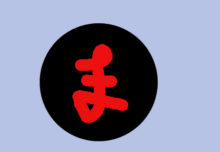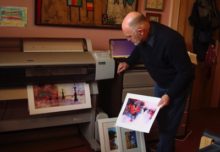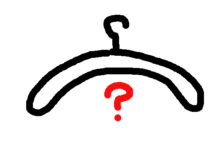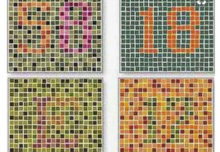OILS, ACRYLICS, and WATERCOLOURS
Oils, acrylics, and water-colours, and are kinds of artists paint.
There are lots of ways to make coloured marks on a surface. This blog is about the common kinds of paints and coloured mark-makers that artists usually use. But what is the difference between them and why are there different kinds?
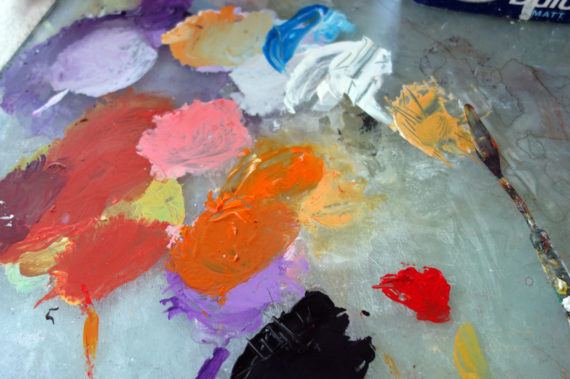
acrylic paint
The basic ingredients of any kind of paint are … Pigment … Filler … Binder.
Pigment.
Pigment is the actual colour. It will be a different chemical mixture for every different colour, and there are thousands of colours. For instance ‘black’ could be made from charcoal, which is carbon. The charcoal would have been ground down into powder consistency and be the colour ingredient ready to make into black paint. Other colours are made from other chemicals, for instance lead oxide is a nice rich red colour, and copper oxide is an interesting green. The trouble is that they can be rather poisonous. However loads of safe natural chemicals do exist that have provided artists with many pigment colours for centuries. Many of these are ‘earth’ colours that are just ground up rocks. Umber, sienna, ochre, chalk white, are everyday examples.
‘Umber…an earth consisting chiefly of a hydrated oxide of iron and some oxide of manganese, used in its natural state as a brown pigment (raw umber) or, after heating, as a reddish-brown pigment (burnt umber)’
In the history of paint there are some striking examples of much more expensive pigments. Some quite common everyday colours were once made from very rare ingredients. Lapiz lazuli springs to mind. It is a semi-precious gem-stone that was imported into Europe and ground up to create the genuine ultramarine blue paint. So if you see an old portrait painting of someone wearing a blue cloak thrown casually over one shoulder it indicates someone with loads of money who could afford to have a blue cloak, and pay an artist to use blue paint to capture the fact for posterity.
Thankfully scientists have discovered many new ways of making pigments. We no longer have to rely on naturally occurring chemical compounds. And they can make almost every colour that artists and paint companies wish to use. They can make most of them at a reasonable cost as well. Hooray!
Filler.
Filler is the least interesting part of paint. But it is necessarily there. Basically it is an inexpensive neutral extender to mix with the pigment to make it go further. This makes the mix cheaper of course. But it also means that manufacturers can make artists colours that are more or less equally strong. Because without neutral filler some colours would be overwhelmingly dominant while others would be pathetically weak. But with neutral fillers included paint manufacturers can make an artists life much better.
The crucial property of the filler is that it bulks out the pigment without altering the colour. A commonly used filler has been ‘Fullers Earth’ which is a naturally occurring clay compound. Just as an aside Fullers Earth is probably the main component of what is in your cats litter tray. Before the cat adds anything.
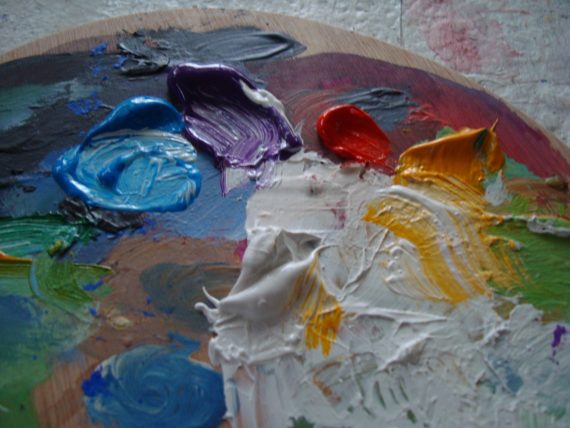
Mixing paint 2
Binder.
The binder is the juice or gluey stuff that holds the pigment and filler together. It also sticks the pigment and filler to the paper, canvas, board, wall, or whatever surface is being painted upon.
So the binder is where our different paint types are different. For instance traditional oil paints are stuck together with linseed oil, acrylics with acrylic resin, and watercolours with gum Arabic. And these binders have different properties.
Linseed oil thins down with turpentine or turps substitute, and dries very slowly. While acrylic resin and gum Arabic thin with water, and dry much faster. But as we all know oil and water don’t mix so you cannot mix oil paint and watercolour, or oil paint and acrylics. But you can mix acrylic and watercolour.
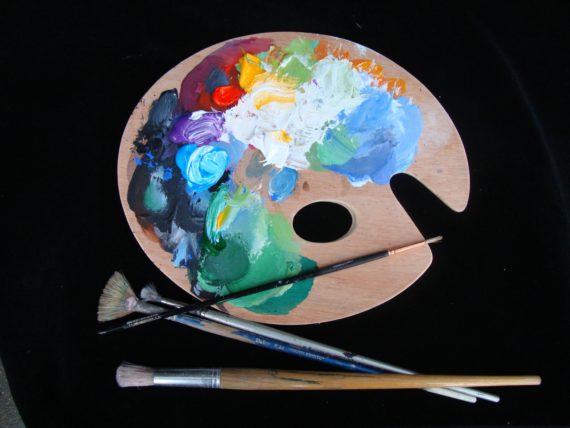
artists palette
Water-colour.
Watercolour is probably the oldest basic sort of paint. Ground up earth pigments are held together with some sort of glue. Our ancestors might have mixed the pigment and water with blood or sap from plants when they painted onto their cave walls. Remember this was before anyone invented paper. Later artists around the Mediterranean and other much hotter places usually painted directly onto the new wet wall. This is ‘Fresco’ painting where the painting is done rapidly in watercolour on wet plaster on a wall or ceiling, so that the colours penetrate the plaster and become fixed as it dries. Fresco was commonly used in Roman times and by the great masters of the Italian Renaissance including Giotto, Raphael, and Michelangelo. Modern watercolour artists use paper of course. Watercolour is not strong or thick enough to paint onto canvas or panels.
Oilpaint.
Linseed oil as a binder making oil paint was developed in cold and wet northern Europe to make paint that would work for artists painting onto wooden panels, or stretched canvas. It is toxic! It takes ages to dry!
But the extra time that it takes to dry opened up new painting techniques for artists. They could re-work areas, over-painting, employ thick impasto texture, and with patience even scumble and glaze was a possible bonus. More about impasto, scumble, and glaze another time.
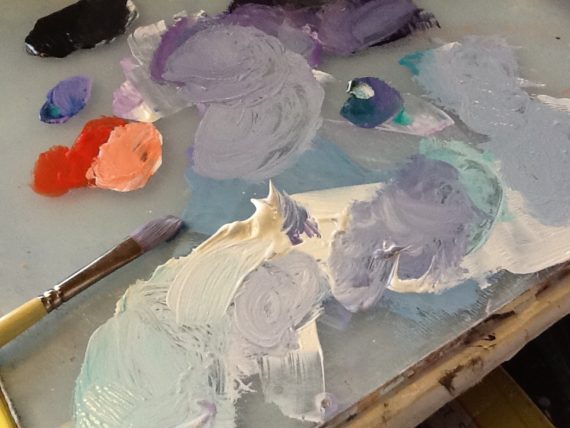
mixing paint 1
Acrylics.
Acrylics are the newest form of paint. The difference between acrylic and watercolour is that acrylics dry and fix, while watercolour dries and doesn’t fix. That means that when an artist paints in acrylics he/she can over-paint one colour over another dry patch without the under-colour becoming wet again. But with watercolour if you paint over dry paint with fresh wet paint the undercolour mixes with the new top colour. These two different paint-mixing characteristics can lead into quite different painting effects, methods, and styles. With acrylics you can scumble and glaze quite easily.
Other types of paint.
Pastels, chalks, and crayons are very stiff paint mixtures made into sticks. There are oil pastels that use an oil to bind the stick together and there are glue based pastels and crayons that might thin with water.
And we haven’t mentioned egg tempera, gesso, or enamels, spray cans, magic markers, or even ink. Another time maybe.
Conclusion.
An artist has a wide confusing choice of ways to make his or her coloured marks. So, before an artist even starts to consider what they are going to paint, they have to decide on the sort of paint they are going to use.

